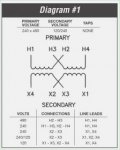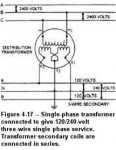drktmplr12
Senior Member
- Location
- South Florida
- Occupation
- Electrical Engineer
The beauty of a real 2 phase system is that with an angular displacement of 180 degrees the math stays on the real number line, at least for resistive loads or adding the voltages between coils.
precisely what happens on the neutral with split phase
another scenario: suppose l2 is disconnected. do i still have potential (and therefore current phasor) in l1-n? of course. what if i attempt to turn on a 240V appliance-is it surprising when the incandescent lights on l2-n turn on?? would they work as expected? by turning on the appliance, a series circuit was created and there is only 120V available to drive the appliance and the backfed light bulbs. so the answer is probably not.


